Molecular glass for optical and electronic devices
- Marketing and Communication Service
- Olga Denia Moreno
- November 11th, 2025

Researchers at the Institute of Molecular Science (ICMol) of the University of Valencia have developed a pioneering method to produce glasses from metal–organic frameworks (MOFs) in a simple and environmentally friendly way. This breakthrough opens new possibilities for the use of MOFs in fields such as electronics, clean energy and advanced technologies. The study has been published in Nature Communications.
Glasses based on metal–organic frameworks (MOFs) are a new class of materials that combine the functional properties of MOFs — compounds worthy of the 2025 Nobel Prize in Chemistry — with the amorphous and processable structure of glass, representing an innovative area within materials science.
Until now, creating certain types of glass used in advanced technology required a complex intermediate step: starting from crystalline structures and then melting and cooling them. However, an international research team led by the University of Valencia has found a far more direct route. By using the organic component itself as the reaction medium and eliminating the harsher conditions of traditional methods, the team succeeded in synthesising a new type of transparent, versatile glass without going through the crystal stage.
This new method makes it possible to work with metals that are particularly difficult to handle, such as iron, and results in pure and highly stable materials. Researchers have named these materials dg-MUV-29 and have demonstrated that their composition can be tailored by incorporating different molecules, which multiplies their potential.
“Our approach not only simplifies synthesis, but also opens the door to working with metals that were previously unfeasible, such as iron. This significantly broadens the range of available functional materials, as it allows us to explore compositions that were inaccessible until now”, explains Guillermo Mínguez, head of the Crystal Engineering Lab (CEL) at ICMol and principal investigator of the project. “These new glasses display exceptional magnetic and optical properties, making them ideal candidates for cutting-edge applications in electronics, smart sensors and sustainable energy technologies”, the scientist adds.
The truly innovative aspect of this clean process is that it allows for detailed study of the magnetic properties of these materials — something that had been extremely difficult until now. In addition, the team has managed to develop and integrate these molecular glasses into optoelectronic devices, paving the way for their future application in advanced electronic systems, smart sensors and sustainable energy technologies. “The possibility of manufacturing these glasses directly and using them in real devices marks a paradigm shift in the design of functional materials”, highlights Luis León, first author of the study. “This approach not only simplifies their production but also demonstrates their technological viability, which opens new avenues for developing high-performance optical and magnetic materials”.
According to the article published in Nature Communications, this advance paves the way for a new generation of smart glass that could transform the way we store energy, design new electronic devices and manufacture extremely sensitive sensors.
In addition to the University of Valencia, the study involved the Institut Laue-Langevin in Grenoble (France), the Rutherford Appleton Laboratory in Oxfordshire (UK), the University of Nottingham (UK) and the University of Lisbon (Portugal).
Reference:
Direct synthesis of an iron metal-organic framework antiferromagnetic glass. Luis León-Alcaide, Lucía Martínez-Goyeneche, Michele Sessolo, Bruno J. C. Vieira, João C. Waerenborgh, J. Alberto Rodríguez-Velamazán, Oscar Fabelo, Matthew J. Cliffe, David A. Keen & Guillermo Mínguez Espallargas. Nature Communications 2025
Categories: Química , Ciencias Tecnológicas , Ciencias Económicas















